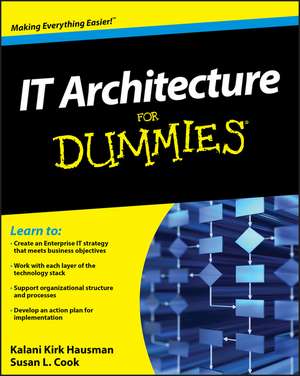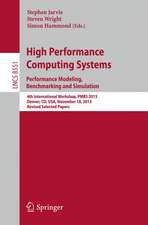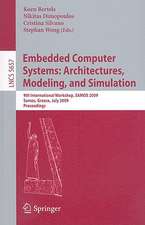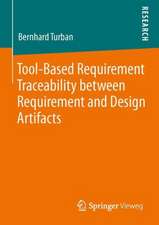IT Architecture For Dummies
Autor KK Hausmanen Limba Engleză Paperback – 4 noi 2010
Preț: 143.81 lei
Preț vechi: 179.76 lei
-20% Nou
Puncte Express: 216
Preț estimativ în valută:
27.52€ • 29.88$ • 23.12£
27.52€ • 29.88$ • 23.12£
Carte disponibilă
Livrare economică 01-15 aprilie
Livrare express 15-21 martie pentru 29.81 lei
Preluare comenzi: 021 569.72.76
Specificații
ISBN-13: 9780470554234
ISBN-10: 0470554231
Pagini: 368
Ilustrații: Illustrations
Dimensiuni: 187 x 234 x 20 mm
Greutate: 0.53 kg
Editura: Wiley
Locul publicării:Hoboken, United States
ISBN-10: 0470554231
Pagini: 368
Ilustrații: Illustrations
Dimensiuni: 187 x 234 x 20 mm
Greutate: 0.53 kg
Editura: Wiley
Locul publicării:Hoboken, United States
Public țintă
Primary Audience. Technical professionals, business executives, and mangers involved in aligning the IT structure of their organization with the missions, goals, and objectives of the business. The book will also benefit technical professionals (network engineers, system administrators, database administrators, and developers) who want to take the next step in their IT succession paths. Secondary Audience. Project managers who form and lead teams for medium to large or global projects and students of enterprise architectural design along with any individual technician responsible for IT implementation.Notă biografică
Kalani Kirk Hausman is a specialist in enterprise architecture, security, information assurance, business continuity, and regulatory compliance. Susan L. Cook is a Senior IT Policy and Security Programs Administrator and a former compliance auditor. Both are employed by Texas A&M University.
Cuprins
Introduction. Part I: Developing the Architecture. Chapter 1: Planning for Enterprise Realignment. Chapter 2: Exploring Tasks, Roles, and Tools. Chapter 3: Pondering Platform Pros and Cons. Part II: Defining the Role of IT Architecture. Chapter 4: Reducing Complexity through Standardization and Consolidation. Chapter 5: Planning Enterprise Information Security. Chapter 6: Complying with Mandates and Managing Risk Part III: Creating an Enterprise Culture. Chapter 7: Developing Identity and Access Management Strategies. Chapter 8: Developing a Network Culture through Collaboration Solutions. Chapter 9: Reviewing Communication Methods. Part IV: Developing an Extended Network Enterprise. Chapter 10: Managing Data Storage. Chapter 11: Managing Application Development. Chapter 12: Planning for the Mobile Enterprise. Part V: Obtaining Value beyond the Basic Enterprise. Chapter 13: Virtualizing Enterprise Systems. Chapter 14: Facilitating High-Performance Computing. Chapter 15: Enabling Green IT. Part VI: Protecting the Enterprise. Chapter 16: Planning Technology Updates. Chapter 17: Planning Security Strategies. Chapter 18: Planning Business Continuity and Disaster Recovery. Part VII: The Part of Tens. Chapter 19: Ten Challenges for Redesigning an Existing Enterprise. Chapter 20: Ten "Low-Hanging Fruit" Opportunities. Glossary. Index.


























